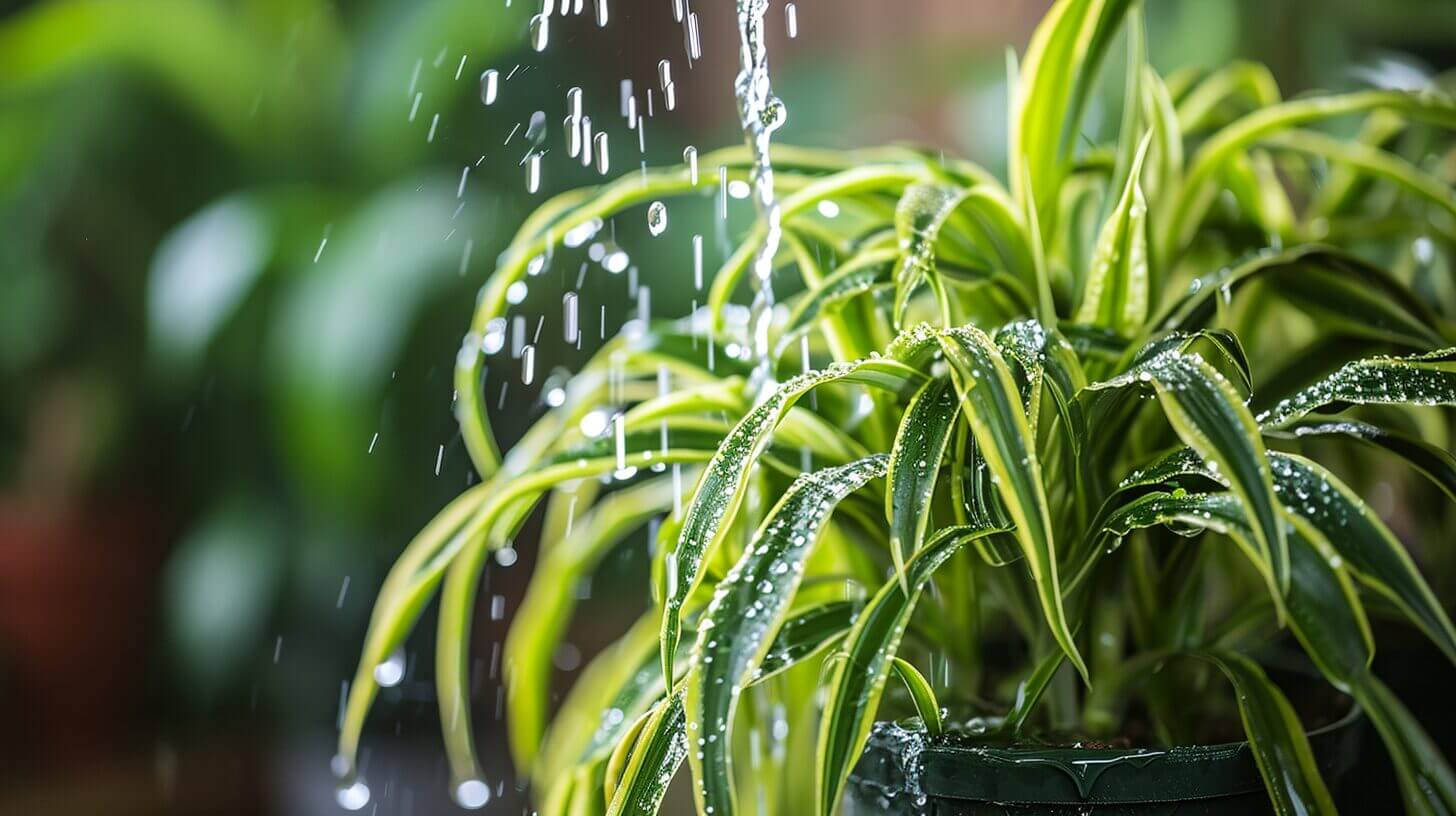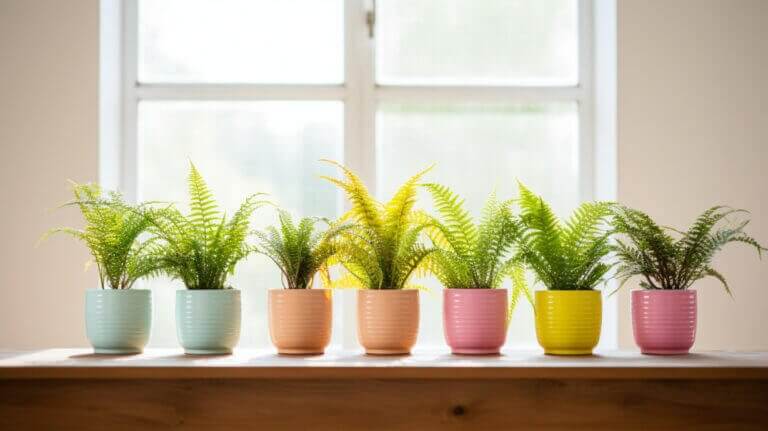Just like a well-conducted symphony, caring for a spider plant requires precision and harmony. In this informative guide, we will explore the factors to consider when determining the watering frequency for your spider plant.
By understanding the signs of overwatering and underwatering, and implementing best practices, you can ensure the health and vitality of your beloved spider plant.
Key Takeaways
- Wait until the top inch of soil is dry before watering again to avoid overwatering and root rot.
- Water spider plants from the bottom by placing them in a tray or saucer filled with water for 30 minutes.
- Adjust watering frequency based on factors such as plant size, environmental conditions, and growth stage.
- Regularly check the soil moisture level and adjust watering accordingly to maintain a healthy balance between overwatering and underwatering.
Understanding the Watering Needs of Spider Plants
To properly care for spider plants, it is crucial to understand their specific watering requirements. Spider plants are relatively low-maintenance and forgiving when it comes to watering, but there are still some key techniques to keep in mind.
One common mistake is overwatering, as spider plants are susceptible to root rot if their soil is consistently waterlogged. It is recommended to wait until the top inch of soil is dry before watering again.
Another technique is to water spider plants from the bottom, allowing the roots to soak up the water they need. This can be done by placing the plant in a tray or saucer filled with water for about 30 minutes, and then removing any excess water.
Factors to Consider When Determining Watering Frequency
Taking into account the specific needs of spider plants, several factors should be considered when determining the appropriate frequency of watering. By considering these factors, you can ensure that your spider plant stays healthy and free from issues such as root rot.
Here are four key factors to consider:
- Plant size: Larger spider plants generally require more water than smaller ones. Take into consideration the size of your plant when determining watering frequency.
- Environmental conditions: Factors such as temperature, humidity, and sunlight can affect the water needs of your spider plant. Be mindful of the conditions in your plant’s environment and adjust watering accordingly.
- Potting medium: The type of soil or potting mix used can impact water retention. Ensure that the potting medium drains well to prevent waterlogged roots and potential root rot.
- Plant growth stage: Spider plants may have different water requirements during periods of active growth versus periods of dormancy. Adjust your watering schedule accordingly.
Signs of Overwatering and Underwatering in Spider Plants
What are the signs of overwatering and underwatering in spider plants? It is important to be able to identify these signs in order to prevent common mistakes and avoid the development of root rot.
Overwatering is a common problem that can lead to the deterioration of spider plants. Signs of overwatering include yellowing leaves, mushy and discolored roots, and a foul odor coming from the soil.
On the other hand, underwatering can also be detrimental to spider plants. Signs of underwatering include dry and crispy leaves, brown tips, and wilting.
To prevent root rot, it is crucial to find the right balance between overwatering and underwatering. Regularly check the moisture level of the soil and adjust your watering schedule accordingly.
Best Practices for Watering Spider Plants
When watering spider plants, it is important to follow best practices in order to promote healthy growth and prevent issues such as root rot.
Here are some proper watering techniques and common watering mistakes to avoid:
- Watering frequency: Spider plants prefer slightly moist soil, so water them when the top inch of soil feels dry. Avoid overwatering, as it can lead to root rot.
- Watering method: Use a watering can or a gentle stream of water to moisten the soil evenly. Avoid getting water on the leaves as it can cause damage or encourage disease.
- Drainage: Ensure that the pot has drainage holes to allow excess water to escape. This helps prevent waterlogged soil.
- Consistency: Be consistent with your watering schedule. Spider plants prefer regular, moderate watering rather than sporadic heavy watering.
Adjusting Watering Frequency Based on Seasonal Changes
As the seasons change, you should adjust the watering frequency of your spider plant to ensure optimal growth and health. Spider plants have different water requirements during different seasons, so it’s important to make the necessary watering adjustments for proper plant care.
During the warmer months, spider plants tend to require more water due to increased evaporation and higher temperatures. It is recommended to water your spider plant every 7-10 days during the summer.
On the other hand, during the colder months, spider plants enter a dormant phase and require less water. It is best to water your spider plant every 2-3 weeks during the winter.
Frequently Asked Questions
Can Spider Plants Be Watered With Tap Water, or Is It Better to Use Filtered or Distilled Water?
Tap water can be used to water spider plants, but there are certain considerations regarding water quality. While tap water is generally safe for spider plants, it may contain chemicals such as chlorine and fluoride that can potentially harm the plant.
Using filtered or distilled water can help minimize the impact of these chemicals on the plant’s health. However, it is important to strike a balance and not overdo it, as excessive use of filtered or distilled water can also cause mineral deficiencies in the plant.
Should I Mist My Spider Plant’s Leaves in Addition to Watering the Soil?
Misting the leaves of a spider plant can provide some benefits. It can help increase humidity around the plant, which is beneficial since spider plants thrive in moderate humidity.
Misting can also remove dust and debris from the leaves, improving their overall health and appearance.
However, it’s important to note that misting should not replace watering the soil. While misting can be done occasionally, regular watering of the soil is crucial for the plant’s overall water needs.
How Long Does It Take for a Spider Plant to Recover From Overwatering?
The recovery time from overwatering a spider plant can vary depending on the severity of the damage. Signs of overwatering include yellowing or wilting leaves, root rot, and a waterlogged soil.
To help the plant recover, it is essential to allow the soil to dry out completely before watering again. This can take anywhere from a few days to a couple of weeks.
Additionally, ensuring proper drainage and adjusting watering frequency can prevent future overwatering issues.
How Does Proper Watering Affect the Trimming Process of a Spider Plant?
Using a self-watering pot for your spider plant can be a convenient and effective way to maintain the plant’s moisture levels.
However, it is important to consider alternative options as well. Self-watering pots offer benefits such as water efficiency and reduced risk of overwatering.
However, other methods like using a moisture meter or implementing a watering schedule can also provide similar results.
It ultimately depends on your personal preference and the specific needs of your spider plant.
How Do I Prevent Root Rot in Spider Plants?
To prevent root rot in spider plants, it is crucial to understand the signs of overwatering. Overwatering can lead to waterlogged soil, which deprives the roots of oxygen and promotes rot.
To avoid this, ensure that the plant is in well-draining soil and that the pot has drainage holes. Additionally, allow the top inch of soil to dry out before watering again.
Regularly inspect the plant for yellowing leaves, wilting, or a foul odor, as these may indicate root rot.







